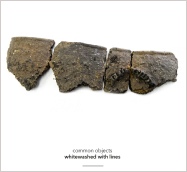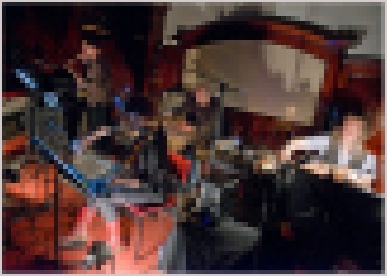Another Timbre TimHarrisonbre

at85x2 Whitewashed with Lines by Common Objects
Double CD with two performances by Common Objects
John Butcher saxophones
Angharad Davies violin
Rhodri Davies harps
Lee Patterson amplified devices and processes
Disc One: cup and ring 57:10 recorded in Newcastle, April 2014
Disc Two: repose and vertigo 43:45 recorded in Durham, May 2013
Youtube extract (from ‘repose and vertigo’)
Sleevenotes by Rhodri Davies
My first encounter with cup and ring marked stones was in 2007 while working on HALF LIFE, a co-production between The National Theatre of Scotland and NVA with the sound curated by Barry Esson. Angharad Davies and I were composing and performing the music for two weeks for this outdoor production in the forest, in the dark, near the entrance to Kilmartin Glen in Argyll. Lee Patterson was also making sound art installations with Toshiya Tsunoda around significant prehistoric locations in the region. Angus Farquhar (creative director of NVA and member of Test Dept.) took us on many site visits and his infectious enthusiasm about the Neolithic era has remained with me ever since.
I moved to the North East of England soon after HALF LIFE and I was excited to be living close to so many cup and ring sites. Rebecca Shatwell and the AV Festival 2014 gave me a chance to explore this interest more deeply through two commissions: the first a collaboration with John Butcher called ‘Routing Lynn’ (released on ftarri-217), and ‘cup and ring’, a graphic score that I constructed for Common Objects and which is released on disc one. A chance encounter with the sound poet Bob Cobbing in the mid-1990s kick-started my fascination with Sound and Concrete Poetry and the process of converting image into sound. Since then many of my composed pieces have included graphic notation. When I saw cup and ring marked stones for the first time I thought they would make excellent material for a graphic score. The fact that so many interpretations of their function and meaning exist, and that a definitive reading of their significance still remains unknown, make them excellent inspiration for an open score. The live ‘cup and ring’ performance at The Mining Institute in Newcastle, as part of AV Festival 2014, had an unusual energy, and perhaps the aura was heightened further by an audience member making gestures and loud breathing sounds during the performance, as can be heard on this recording. For the score I drew on the book Archaic Rock Inscriptions: An Account of the Cup & Ring Markings on the Sculptured Stones of the Old and New Worlds (A. Reader 1891) as well as a number of books by the pioneering rock art expert Stan Beckensall.
‘repose and vertigo’ on disc two is a group improvisation, again performed in the North East of England, one year earlier than ‘cup and ring’. Andy Hamilton invited me to co-convene a Symposium on the ‘Aesthetics of Imperfection’ at Senate House, Durham University, and Common Objects played in the evening.
The two concerts presented on this release reveal different modes of working: one is an interpretation of an open graphic score and the other is a group improvisation. The members of the ensemble are the same for both concerts, but with slightly differing instrumentation and performing in two different acoustics. In placing them side-by-side, I hope to highlight the subtle differences in the group’s working processes.
Rhodri Davies
Reviews
“This double CD documents a series of intertwined geological, compositional and improvisational designs acoustically rendered by a supergroup of sorts. The pairing of different live performances — in Newcastle and Durham, respectively — warrants an admirable balance between coincidental and predetermined events. The instrumentation is comprised of electric harp (Rhodri Davies), violin (Angharad Davies), saxophones (John Butcher) besides the "amplified devices and processes" operated by Lee Patterson.
The first set encloses the quartet's interpretation of "Cup And Ring", a graphic score by Davies based on his interest on the namesake stones and their fascinating marks. The Welsh harpist found the source useful enough to try and develop interesting sonorities influenced by those patterns. The resulting music shows all the "right" facets of the sonic polymorphism to be expected from each participant's expertise in the field. Across dynamics shifts occurring inside a compass of relative restriction, we discern brain-numbing harmonics, biotic propagations, wheezy multiphonics, subsonic quaking, inherent pulsations, electrical matters, gradual crescendos. Every gesture is defined by a pronounced tension; when states of unstable quietness are reached, more conceptions of modification and decay naturally arise to delineate new environments. The piece is lengthy, but never overstays its welcome; even better, there are no segments of trendy "fake zen" inactivity.
The same firm confidence pervades the bulk of "Repose And Vertigo", by all accounts an improvisation in spite of an equally organized appearance. Here the single voices become clearly visible — and possibly stronger — in the overall enhanced concreteness of a rather composite performance. However, in selected sections of this context we notice the emergence of an increased sense of urgency. There the sounds coalesce in lumps along parallel paths, occasionally attempting a transition towards the "fff" regions, always maintaining a distinct personality in the indisputable ethicalness of the whole. Still, the track preserves the gripping characteristics of a rigorous ceremonial deprived of futile appendixes: each drone, scrape, yelp or clattering growl is there for a reason, facilitating the mind in the achievement of a receptive focus that welcomes "harmonic noise" while shutting out that generated by the average human behavior.”
Massimo Ricci, Squid’s Ear

Performing ‘cup and ring’ at the AV Festival, Newcastle, 2014
Discount price £10